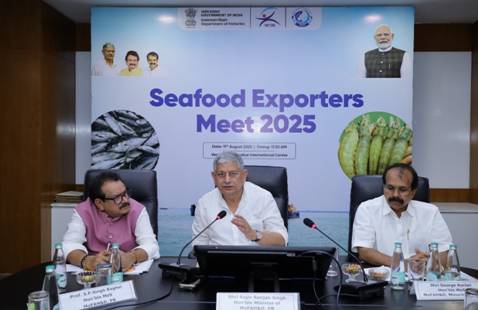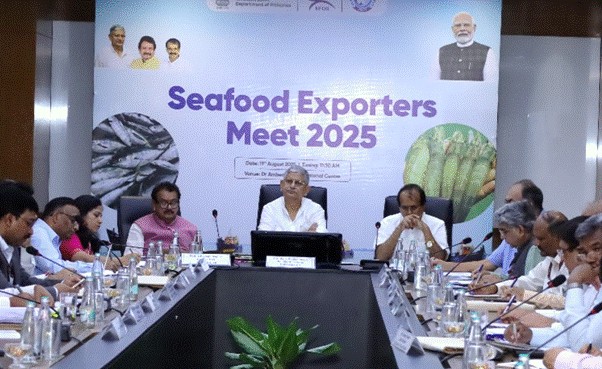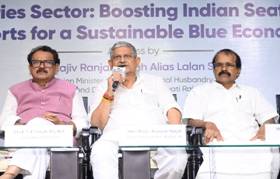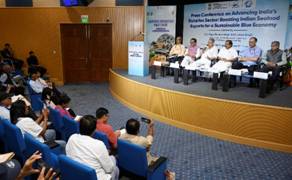Ministry of Fisheries, Animal Husbandry & Dairying
Union Minister Shri Rajiv Ranjan Singh Chairs Seafood Exporters Meet 2025 in New Delhi; Chart Strategy to Expand Global Market Reach
“Value addition & Identifying State-Specific Species hold key to boosting India’s seafood exports” says Union Minister Shri Rajiv Ranjan Singh
प्रविष्टि तिथि:
11 AUG 2025 6:41PM by PIB Delhi
The Department of Fisheries under the Ministry of Fisheries, Animal Husbandry & Dairying organized a Seafood Exporters Meet 2025 today at Ambedkar Bhawan, New Delhi. The meet was graced by Union Minister, Ministry of Fisheries, Animal Husbandry & Dairying (MoFAH&D) and Ministry of Panchayati Raj (MoPR), Shri Rajiv Ranjan Singh alias Lalan Singh along with Minister of State, MoFAH&D and MoPR Prof. S.P. Singh Baghel and Minister of State Shri George Kurian, MoFAH&D and Ministry of Minority Affairs.
The meeting was attended by officials from the Department of Commerce, Marine Products Export Development Authority (MPEDA),National Fisheries Development Board (NFDB), Export Inspection Council (EIC), National Bank for Agriculture and Rural Development (NABARD), industry representatives and progressive farmers. It also saw participation of senior officials from the Department of Fisheries, Government of India, along with the Fisheries Departments of Andhra Pradesh, Tamil Nadu, Odisha and Gujarat.


During the meeting, Union Minister Shri Rajiv Ranjan Singh underscored the importance of value addition in Indian seafood to enhance its export potential. He highlighted the ongoing government initiatives being taken in the fisheries sector, including the development of a single-window system for better market linkages for all stakeholders, strengthening of High Seas and Exclusive Economic Zone (EEZ) fishing, and upgrading infrastructure, all aimed at further bolstering the fisheries sector. The Union Minister emphasized on MPEDA’s pivotal role in navigating the tariff challenges faced by the industry and urged MPEDA, along with state governments, to conduct stakeholder consultations for accurate mapping of state-wise species-specific exports and identifying new export opportunities. He also assured the stakeholders of the government’s commitment to further strengthening Indian seafood exports.
In his address, Prof. S.P. Singh Baghel highlighted the vast fisheries resources of the country and urged the stakeholders to leverage them to boost India’s exports. He emphasised the importance of identifying and tapping new markets to mitigate global market risks and called upon all stakeholders to work in close collaboration with state governments to strengthen and expand the seafood value chain.
Shri George Kurian reiterated the “Vocal for Local” vision, stressing that strengthening domestic markets would create fresh avenues for fishers and farmers, especially in the face of global tariff challenges.
Dr. Abhilaksh Likhi, Secretary (Fisheries), MoFAH&D, highlighted that only about 10% of India’s seafood exports by value are currently value-added products, stressing the need to raise this share to 30–60% in line with global benchmarks through enhanced domestic production or import-and-re-export strategies. He expressed concern over the heavy dependence on a single species, Whiteleg shrimp which accounts for 62% of export value but only 38% of quantity. Dr. Likhi stated the urgency of reducing post-harvest losses and assured that issues related to tariff and non-tariff barriers would be addressed in coordination with the Department of Commerce, Ministry of External Affairs, and other relevant authorities. He also called for targeted inputs to identify and finance infrastructure upgrades that would significantly boost value addition across the seafood export value chain.
Stakeholders at the meeting highlighted key challenges in boosting seafood exports, including the need for greater value addition where competing nations like China offer strong incentives, tariff barriers in major markets such as the United States, and certification and compliance hurdles for accessing high-value destinations like the EU. They also pointed to non-tariff barriers such as private testing, third-party clearances, and farm certifications, along with gaps in cold chain and processing infrastructure for niche products like rainbow trout. Suggestions included extending scheme benefits to larger exporters, introducing incentives for value addition, strengthening government-backed certification support, enhancing infrastructure, facilitating B2B linkages with global buyers, and improving access to finance through banks and NBFCs. Alternative markets identified for expansion included the UK, EU, Oman, UAE, South Korea, Russia, and China, with particular emphasis on South Korea’s potential and the Middle East’s growing demand.


Following the consultation meeting, the Union Minister along with Ministers of State, MoFAH&D addressed the press, engaging with media representatives on a wide range of critical topics concerning the future of India’s seafood exports. Shri Rajiv Ranjan Singh spoke in detail about the pressing challenges posed by recent US tariffs and outlined the Government’s proactive measures to safeguard the interests of exporters and maintain India’s competitive edge in the global markets. The Union Minister also highlighted the achievements of the fisheries sector in recent years, underlining the substantial growth in production, infrastructure development, and market diversification. Furthermore, he shared insights on the various flagship schemes and initiatives being implemented to strengthen the seafood value chain in India.
Background
India’s annual fish production has witnessed a significant growth of 104%, rising from 95.79 lakh tonnes in FY 2013-14 to 195 lakh tonnes in FY 2024-25. Inland fisheries and aquaculture have emerged as key contributors, accounting for over 75% of the total production. India exported 17.81 lakh metric tonnes (MT) of seafood during the financial year 2023–24. The total value of these exports was ₹60,523.89 crore, which is equivalent to US$7.38 billion. This represents a slight increase in export volume compared to 17.35 lakh MT in 2022–23. Frozen shrimp continued to be the most significant item in India’s seafood export basket. It earned ₹40,013.54 crore (US$4.88 billion), accounting for 40.19% of the total export quantity and 66.12% of the total earnings in dollar terms. In 2023–24, India exported 7.16 lakh MT of frozen shrimp.
****
Aditi Agrawal
(रिलीज़ आईडी: 2155190)
आगंतुक पटल : 463